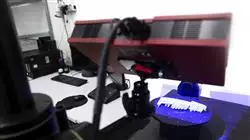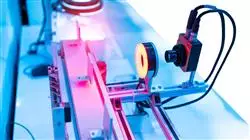University certificate
The world's largest artificial intelligence faculty”
Introduction to the Program
Optimize your practice with the most innovative strategies in Web Computer Vision thanks to this 100% online program"

Image segmentation with Deep Learning has led to significant advances in fields such as robotics, medicine or security. The main reason is that these systems make it possible to automate complex tasks and analyze large volumes of data in a short period of time. Therefore, experts gain a better understanding thanks to accurate images of the objects of interest. However, in order to enjoy its multiple benefits, it is essential that professionals acquire new skills and incorporate the latest advances in this area into their usual procedures.
For this reason, TECH implements a Postgraduate diploma that will delve into Advanced Web Computer Vision Techniques. Designed by experts in this field, the curriculum will delve into 3D image processing, using the most innovative software for the visualization of materials. The syllabus will also focus on photo segmentation methods using Deep Learning Moreover, students will examine in detail the Semantic Segmentation Project to develop systems that require an accurate understanding of digital images. It should be noted that the academic itinerary will include the analysis of real case studies and exercises aimed at raising students' competencies.
Regarding the methodology of the program, it is taught 100% online. In this sense, the only thing students will need is an electronic device with Internet access to enter the Virtual Campus and enjoy the most dynamic didactic content. In addition, TECH uses an innovative pedagogical system:Relearning. This consists of repeating the key contents in a natural way, so that students can learn progressively. Undoubtedly, this is an excellent opportunity for professionals to get a complete update through a university program that adapts to the real needs of experts.
You will have full mastery of Generative Adversarial Networks and create high quality multimedia content”
This Postgraduate diploma in Advanced Web-Based Computer Vision Techniques contains the most complete and up-to-date program on the market. The most important features include:
- The development of case studies presented by experts in computer science and computer vision
- The graphic, schematic and practical contents with which it is conceived scientific and practical information on those disciplines that are essential for professional practice
- Practical exercises where self-assessment can be used to improve learning
- Its special emphasis on innovative methodologies
- Theoretical lessons, questions to the expert, debate forums on controversial topics, and individual reflection assignments
- Content that is accessible from any fixed or portable device with an Internet connection
You will access the most effective databases to solve general segmentation problems and evaluate algorithms effectively”
The program’s teaching staff includes professionals from the industry who contribute their work experience to this program, as well as renowned specialists from leading societies and prestigious universities.
The multimedia content, developed with the latest educational technology, will provide the professional with situated and contextual learning, i.e., a simulated environment that will provide immersive education programmed to learn in real situations.
This program is designed around Problem-Based Learning, whereby the professional must try to solve the different professional practice situations that arise during the academic year For this purpose, the students will be assisted by an innovative interactive video system created by renowned and experienced experts.
You will be highly qualified to handle the various segmentation tools using different frameworks"

The Relearning system will lead you to advance in a much more agile way through image segmentation with Deep Learning"
Why study at TECH?
TECH is the world’s largest online university. With an impressive catalog of more than 14,000 university programs available in 11 languages, it is positioned as a leader in employability, with a 99% job placement rate. In addition, it relies on an enormous faculty of more than 6,000 professors of the highest international renown.

Study at the world's largest online university and guarantee your professional success. The future starts at TECH”
The world’s best online university according to FORBES
The prestigious Forbes magazine, specialized in business and finance, has highlighted TECH as “the world's best online university” This is what they have recently stated in an article in their digital edition in which they echo the success story of this institution, “thanks to the academic offer it provides, the selection of its teaching staff, and an innovative learning method aimed at educating the professionals of the future”
A revolutionary study method, a cutting-edge faculty and a practical focus: the key to TECH's success.
The most complete study plans on the university scene
TECH offers the most complete study plans on the university scene, with syllabuses that cover fundamental concepts and, at the same time, the main scientific advances in their specific scientific areas. In addition, these programs are continuously being updated to guarantee students the academic vanguard and the most in-demand professional skills. In this way, the university's qualifications provide its graduates with a significant advantage to propel their careers to success.
TECH offers the most comprehensive and intensive study plans on the current university scene.
A world-class teaching staff
TECH's teaching staff is made up of more than 6,000 professors with the highest international recognition. Professors, researchers and top executives of multinational companies, including Isaiah Covington, performance coach of the Boston Celtics; Magda Romanska, principal investigator at Harvard MetaLAB; Ignacio Wistumba, chairman of the department of translational molecular pathology at MD Anderson Cancer Center; and D.W. Pine, creative director of TIME magazine, among others.
Internationally renowned experts, specialized in different branches of Health, Technology, Communication and Business, form part of the TECH faculty.
A unique learning method
TECH is the first university to use Relearning in all its programs. It is the best online learning methodology, accredited with international teaching quality certifications, provided by prestigious educational agencies. In addition, this disruptive educational model is complemented with the “Case Method”, thereby setting up a unique online teaching strategy. Innovative teaching resources are also implemented, including detailed videos, infographics and interactive summaries.
TECH combines Relearning and the Case Method in all its university programs to guarantee excellent theoretical and practical learning, studying whenever and wherever you want.
The world's largest online university
TECH is the world’s largest online university. We are the largest educational institution, with the best and widest online educational catalog, one hundred percent online and covering the vast majority of areas of knowledge. We offer a large selection of our own degrees and accredited online undergraduate and postgraduate degrees. In total, more than 14,000 university degrees, in eleven different languages, make us the largest educational largest in the world.
TECH has the world's most extensive catalog of academic and official programs, available in more than 11 languages.
Google Premier Partner
The American technology giant has awarded TECH the Google Google Premier Partner badge. This award, which is only available to 3% of the world's companies, highlights the efficient, flexible and tailored experience that this university provides to students. The recognition as a Google Premier Partner not only accredits the maximum rigor, performance and investment in TECH's digital infrastructures, but also places this university as one of the world's leading technology companies.
Google has positioned TECH in the top 3% of the world's most important technology companies by awarding it its Google Premier Partner badge.
The official online university of the NBA
TECH is the official online university of the NBA. Thanks to our agreement with the biggest league in basketball, we offer our students exclusive university programs, as well as a wide variety of educational resources focused on the business of the league and other areas of the sports industry. Each program is made up of a uniquely designed syllabus and features exceptional guest hosts: professionals with a distinguished sports background who will offer their expertise on the most relevant topics.
TECH has been selected by the NBA, the world's top basketball league, as its official online university.
The top-rated university by its students
Students have positioned TECH as the world's top-rated university on the main review websites, with a highest rating of 4.9 out of 5, obtained from more than 1,000 reviews. These results consolidate TECH as the benchmark university institution at an international level, reflecting the excellence and positive impact of its educational model.” reflecting the excellence and positive impact of its educational model.”
TECH is the world’s top-rated university by its students.
Leaders in employability
TECH has managed to become the leading university in employability. 99% of its students obtain jobs in the academic field they have studied, within one year of completing any of the university's programs. A similar number achieve immediate career enhancement. All this thanks to a study methodology that bases its effectiveness on the acquisition of practical skills, which are absolutely necessary for professional development.
99% of TECH graduates find a job within a year of completing their studies.
Postgraduate Diploma in Advanced Web-Based Computer Vision Techniques
Enter the exciting world of web computer vision and master the skills needed to lead in this ever-expanding field with the Postgraduate Diploma created by TECH Global University. Designed for students and professionals passionate about visual computing and web development, this course will provide you with an in-depth understanding of the advanced techniques and practical applications of computer vision in web environments. Through an innovative syllabus, delivered in an online modality, you will explore the fundamentals of computer vision, including image acquisition, digital image processing, and feature extraction. You will learn how computer systems can interpret and understand images in the context of web applications. You will develop advanced web development skills to implement computer vision systems in online environments. You will learn how to integrate computer vision algorithms into web applications using modern technologies such as HTML5, CSS3, JavaScript and web development frameworks.
Get qualified with a Postgraduate Diploma in Advanced Web-Based Computer Vision Techniques
In this innovative program, created by specialists, you'll discover the various practical applications of computer vision in web environments, including object recognition, motion detection, object tracking and more. You will explore how these technologies can enhance the user experience and add value to web applications. In addition, you will dive into the world of machine learning and artificial intelligence in the context of web computer vision. You will learn how machine learning models can improve the performance of computer vision systems and enable the creation of smarter, more adaptive web applications. From this, you will envision your future as a web computer vision expert, capable of leading in the design and development of advanced web applications. You will become a highly sought-after professional with unique skills to harness the power of computer vision in online environments. Enroll now and begin your journey to excellence in web computer vision!







